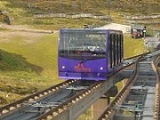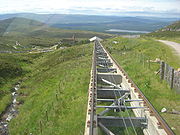
Cairngorm Mountain Railway
Encyclopedia

United Kingdom
The United Kingdom of Great Britain and Northern IrelandIn the United Kingdom and Dependencies, other languages have been officially recognised as legitimate autochthonous languages under the European Charter for Regional or Minority Languages...
since it opened in 2001. The two-kilometre long funicular
Funicular
A funicular, also known as an inclined plane or cliff railway, is a cable railway in which a cable attached to a pair of tram-like vehicles on rails moves them up and down a steep slope; the ascending and descending vehicles counterbalance each other.-Operation:The basic principle of funicular...
ascends the northern slopes of Cairn Gorm
Cairn Gorm
Cairn Gorm is a mountain in the Scottish Highlands overlooking Strathspey and the town of Aviemore. At 1245 metres it is the sixth highest mountain in the United Kingdom...
, the United Kingdom's sixth-highest mountain. The route is located within the Cairngorms National Park
Cairngorms National Park
The Cairngorms National Park is a national park in north east Scotland, established in 2003. It was the second of two national parks established by the Scottish Parliament, after Loch Lomond and the Trossachs National Park, set up in 2002. The park covers the Cairngorms range of mountains, and...
, the largest National Nature Reserve in Britain, near to Aviemore
Aviemore
Aviemore is a town and tourist resort, situated within the Cairngorms National Park in the Highlands of Scotland. It is in the Badenoch and Strathspey committee area, within the Highland council area. The town is popular for skiing and other winter sports, and for hill-walking in the Cairngorm...
in the Highland council area
Highland (council area)
Highland is a council area in the Scottish Highlands and is the largest local government area in both Scotland and the United Kingdom as a whole. It shares borders with the council areas of Moray, Aberdeenshire, Perth and Kinross, and Argyll and Bute. Their councils, and those of Angus and...
of Scotland. The ski area also lies within the Cairngorms National Park.
It is publicly owned, being operated by Cairngorm Mountain Limited and wholly owned by the Highlands and Islands Enterprise
Highlands and Islands Enterprise
Highlands and Islands Enterprise is the Scottish Government's economic and community development agency for a diverse region which covers more than half of Scotland and is home to around 450,000 people....
.
History
Construction of the Cairngorm Mountain Railway started in 1999. It opened on 24 December 2001, forty years after the opening of the White Lady Chair Lift, which it replaced. The reason for the construction was that the chair lift was too sensitive to the strong winds in the area. The track is a broad gaugeBroad gauge
Broad-gauge railways use a track gauge greater than the standard gauge of .- List :For list see: List of broad gauges, by gauge and country- History :...
of 2,000 mm (6 ft 6¾in). The maximum operating speed during the ski season is 10 metres per seconds (36 km/h or 22 mph). This speed is dropped to around 5 metres per second during the rest of the year. Giving approximate journey times of four minutes in winter and nine minutes during the summer (calculated without middle station stops). The single track line has a passing loop just above the middle station. During ascent, the maximum gradient is 23° (1 in 2.5, or 40-percent inclination). The railway starts at the Base Station in the Coirre Cas area, where there is a restaurant, shop, ticket office, hire shop, rangers' office and Disability Sport UK office. The Scottish Ski Club have a building close to the middle station.
At peak times there can be 150,000–160,000 non-winter sports visitors, combined with a further 50,000–60,000 annual sports visitors during the winter. CML can expect to cater for a maximum of 3,000 visitors per day in a peak winter season.
The railway is 8 miles (12.9 km) from Aviemore and can be reached travelling along the B970 and C38 roads to Glenmore. From Glenmore a route is taken through the snow gates and via a one-way system past Coire na Ciste (approximately 3 km or 2 mi). The Base Station is at an altitude of approximately 635 metres (2,083.3 ft) above sea level, the middle station is at approximately 765 metres (2,509.8 ft) and the top Ptarmigan Station is at approximately 1097 metres (3,599.1 ft).
The total length of the funicular railway track is 1970 metres (6,463.3 ft), during which the route rises by 462 metres (1,515.7 ft). Most of the route is single track, with a short passing loop near half way. Up to 120 standing passengers can be carried in each of the systems two carriages.
The train is fully accessible for wheelchair users and both the Base Station and Ptarmgian Station have lift access to all levels.
Depending on wind direction, wind speed trend and weather forecast the trains can operate in winds of 60 mile per hour. As the train approaches the top station it enters a 250 metres (820.2 ft) cut and covered tunnel taking it up to the top platform hidden in the hillside.
The funicular railway operates by 'hauling' up one carriage using electric motors to pull the haul rope as the other carriage descends at the same time. The system is powered by two stationary in series 500 kW electric motors, a gear box and a 'soft start-soft stop' control system which can increase the electrical frequency and vary the current and voltage to control the carriage speeds as they approach or leave a station. An hydraulically operated 'counter' rope is connected to both carriages to maintain haul rope tension. The two carriages are permanently connected by the haul rope and the counter rope and can never operate independently.
The funicular railway system is normally operated from a manned control room within the Ptarmigan building but can also be operated from the Base station control room or from each railway carriage. There are dedicated sophisticated computer control, instrumentation, communication and safety systems for the railway which have a range of back up systems and there are also standby generators and manual back up systems for moving the carriages.
During the ski season, skiers are asked to stay within the designated ski area boundary and climbers and hill walkers are not allowed to use the railway to travel uphill. The railway operators have agreed in conjunction with Scottish Natural Heritage (SNH) to operate a formal visitor management plan, that is in place to protect fragile areas of the mountain environment. This means that for conservation reasons, the public are not allowed to access the mountains during the summer season from Ptarmigan building. However, walkers who have climbed the hill themselves may purchase a downhill ticket at the Ptarmigan building for travelling back down to Base. There are no middle station stops or exits during the summer.

